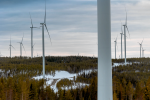How Mining Is Becoming Critical For The Sustainable Transition
Greetings from Tomas Bolsöy, Technical Director here at EOL Ventsystem!
We hope that you are all doing well in these turbulent times.
At EOL Vent, we have had a buzy autumn so far, with a lot of exciting client projects that we will be happy to share with you in the near future.
In our last news post, Samuel talked about the wave of new sustainable industrialization that is currently transforming our home markets of northern Scandinavia.
In this post, we would like to give you EOL Vent's perspective on the sustainability of a whole industry - namely some of our core customers:
The mining industry itself.
Let us show you three important insights that might change the way you view the mining industry and its role in the sustainability transition from now on.
The mining industry will be absolutely critical for a successful transition.
Almost all of the infrastructure and technology needed to reach a carbon-neutral world economy - including wind turbines, solar panels, batteries for vehicles and energy transition systems - depends on the access of minerals from mining. Copper, zinc, aluminium, graphite, nickel and silicon are some of the critical minerals needed and since the demand for all of these technologies are set to increase exponentially during the coming years, a productive and expansive global mining industry will be absolutely critical for a successful transition to a carbon-neutral economy.
According to a recent report from IEA (The International Energy Agency), the total demand for minerals will increase by between 2 to 4 times by 2040, mostly driven by the need for the great sustainability transition, primarily through investments in electricity networks, battery solutions, and electric vehicles.
That's an expected increase from today's total demand of about 15 Mt to 15-27 Mt in just below twenty year - it's hard to put your mind around those figures. It's a LOT of metals.
Recycling will help, but in short, the world needs more minerals.
Since metals and minerals could be considered some of the world's potentially most recyclable materials, shouldn't the current global output of freshly mined metals and minerals be enough for the sustainable transition, when combined with recycled materials?
The short answer, according to a recent report made by SveMin - the Swedish trade organization for mines and mining - is that recycling can indeed help cover between 15-26 % of the expected increase in demand by 2050.
This means that we can still expect a huge demand for freshly mined metals and minerals from mines. The recycled minerals cannot make up for the massive shift in resource use we are seeing in the near future.
And it's not just that the new green economy is growing in size - it's also about the nature of sustainable products. For example, a fossil-driven car contains about 20 kg of copper, while an electric car needs about 70 kg of copper.
Finally, since mines and mining will continue to be one of the world's most important industries for a sustainable transition, we at EOL Vent continue to work for what we strongly believe in, namely that...
Mining itself can be done even more sustainably and efficiently - and there's a business case for sustainable mining as well.
Since mining new minerals and metals will be critical for the global energy transition, one last task remains, and it's a task that lays close to our mission at EOL Ventsystem:
To make sure that the mining operations are always performed as sustainably, energy efficient and safely as possible.
We will be diving deeper into the details of how this can be done in the next post, as well as looking at specifically how EOL Ventsystem are pushing the standards our own industry into a more sustainable direction.
Until next time!
Best regards,
Tomas Bolsöy
Technical Director


